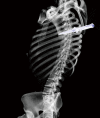Management of chest trauma
- PMID: 28446982
- PMCID: PMC5392544
- DOI: 10.21037/jtd.2017.03.52
Management of chest trauma
Abstract
Trauma is the leading cause of death worldwide. Approximately 2/3 of the patients have a chest trauma with varying severity from a simple rib fracture to penetrating injury of the heart or tracheobronchial disruption. Blunt chest trauma is most common with 90% incidence, of which less than 10% require surgical intervention of any kind. Mortality is second highest after head injury, which underlines the importance of initial management. Many of these deaths can be prevented by prompt diagnosis and treatment. What is the role of the thoracic surgeon in the management of chest trauma in severely injured patients? When should the thoracic surgeon be involved? Is there a place for minimal invasive surgery in the management of severely injured patients? With two case reports we would like to demonstrate how the very specific knowledge of thoracic surgeons could help in the care of trauma patients.
Keywords: Trauma; injury; thorax; video-assisted thoracoscopic surgery (VATS).
Conflict of interest statement
Conflicts of Interest: The authors have no conflicts of interest to declare.
Figures





References
-
- Subcommittee A, American College of Surgeons' Committee on T, International Awg. Advanced trauma life support (ATLS(R)): the ninth edition. J Trauma Acute Care Surg 2013;74:1363-6. - PubMed
-
- Kuhne CA, Ruchholtz S, Sauerland S, et al. Personnel and structural requirements for the shock trauma room management of multiple trauma. A systematic review of the literature. Unfallchirurg 2004;107:851-61. - PubMed
Publication types
LinkOut - more resources
Full Text Sources
Other Literature Sources
